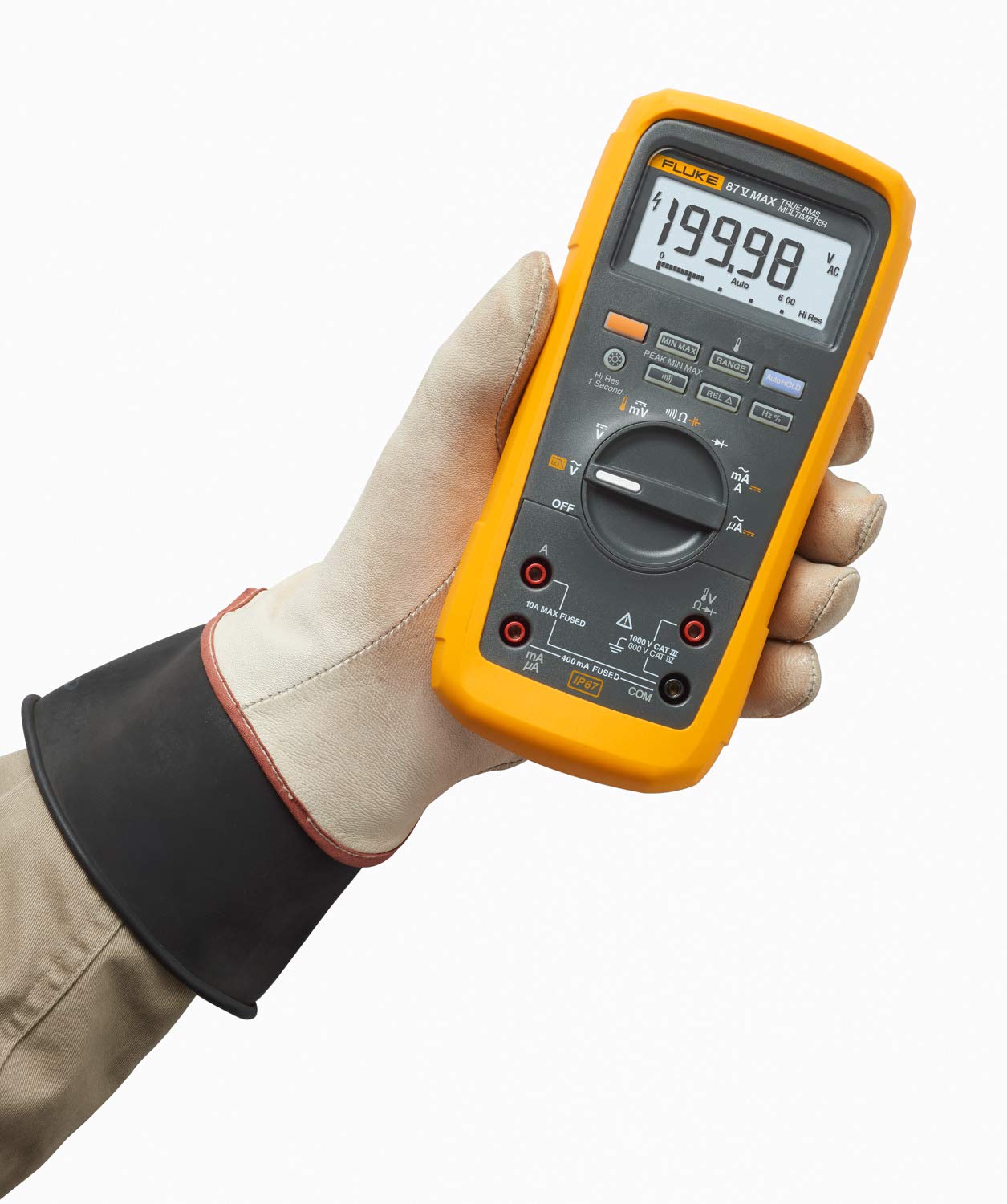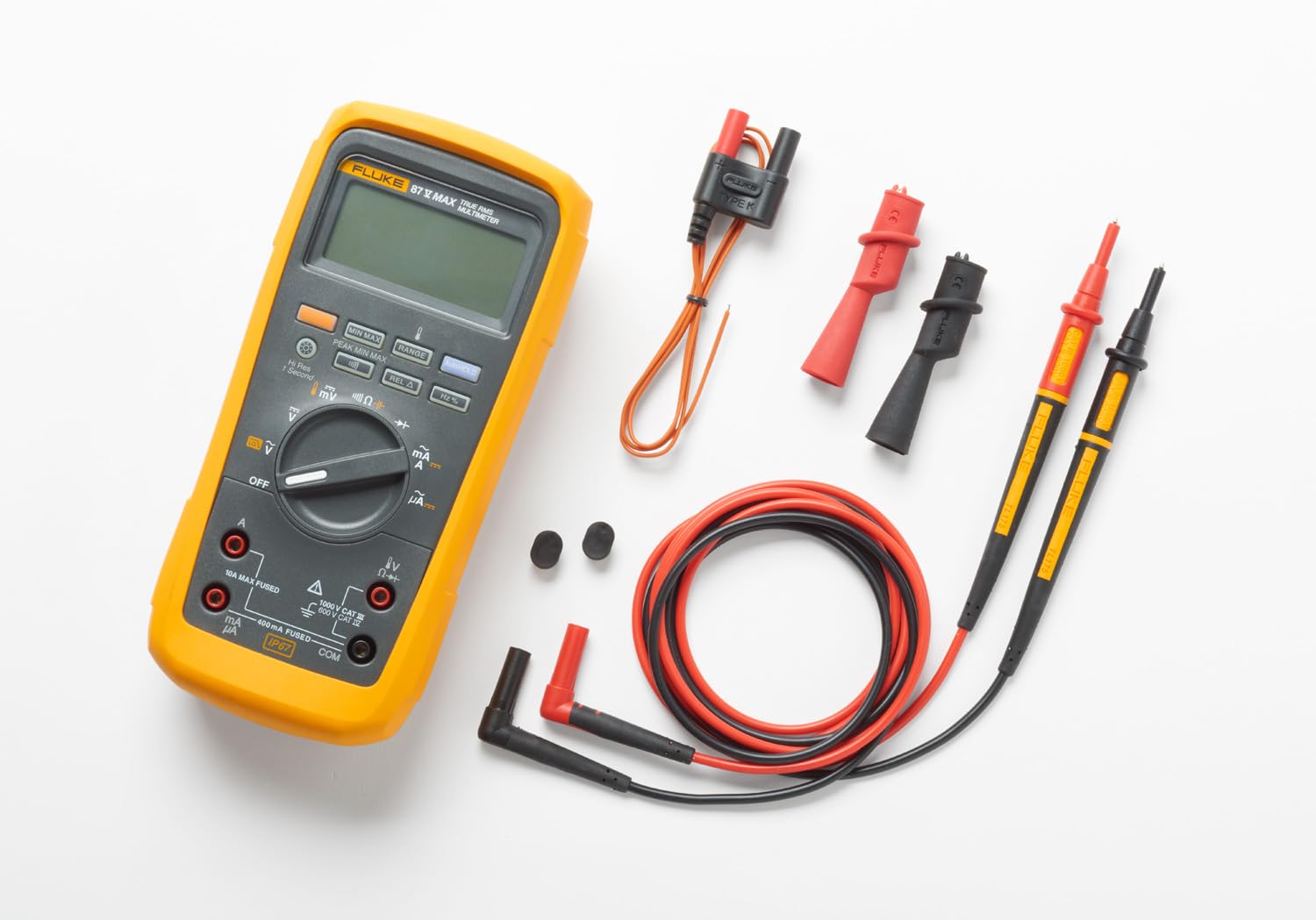Fluke 87V MAX True-RMS Digital Multimeter, Rugged, Waterproof and Dustproof IP67 Rated, Up to 800 Hour Battery Capacity, Built-In Thermometer, Withstands Drops Up To 13 Feet, Includes TL175 Test Leads
$600 Original price was: $600.$510Current price is: $510.
Product Description:
The Fluke 87V MAX is a heavy duty True-RMS Digital Multimeter with IP67 rating and 4-meter drop proven. Built for customers whose job takes them to extreme environments: hot, cold, wet, dirty, up ladders, down a hole. This is the DMM that works where others can’t, plus all the trusted features from regular 87V.
Is Discontinued By Manufacturer : No
Product Dimensions : 11.61 x 16 x 3.35 inches; 1 Pounds
Item model number : FLK-87VMAX
Batteries : 3 AA batteries required. (included)
Date First Available : October 8, 2019
Manufacturer : FLUKE NETWORKS
ASIN : B07YQSBJSB
Country of Origin : China
Best Sellers Rank: #66,044 in Tools & Home Improvement (See Top 100 in Tools & Home Improvement) #99 in Multi Testers
Customer Reviews: 4.7 4.7 out of 5 stars 275 ratings var dpAcrHasRegisteredArcLinkClickAction; P.when(‘A’, ‘ready’).execute(function(A) { if (dpAcrHasRegisteredArcLinkClickAction !== true) { dpAcrHasRegisteredArcLinkClickAction = true; A.declarative( ‘acrLink-click-metrics’, ‘click’, { “allowLinkDefault”: true }, function (event) { if (window.ue) { ue.count(“acrLinkClickCount”, (ue.count(“acrLinkClickCount”) || 0) + 1); } } ); } }); P.when(‘A’, ‘cf’).execute(function(A) { A.declarative(‘acrStarsLink-click-metrics’, ‘click’, { “allowLinkDefault” : true }, function(event){ if(window.ue) { ue.count(“acrStarsLinkWithPopoverClickCount”, (ue.count(“acrStarsLinkWithPopoverClickCount”) || 0) + 1); } }); });
True-RMS accuracy with all functions of 87v and upgraded test leads.
Fully waterproof and dustproof with IP67 rating and 4-meter drop proven. Built to take too harsh and extreme environments.
Safety rated CAT III 1000 V, CAT IV 600 V meter to get you home safely from the job.
Lifetime, backed by a brand you trust.
Product Summary:
Customers say
Customers find the multimeter accurate, with one noting its true RMS readings and resistance accuracy. The device is durable, with customers saying it lasts a lifetime, and is easy to use, with one mentioning it’s suitable for professionals and knowledgeable DIYers. They consider it worth the money and appreciate its functionality, with one customer noting it’s perfect for servicing medical equipment. While customers like the build quality, they find the device bulky and too large for everyday work.
AI Generated from the text of customer reviews
Item Details:
Products Reviews:
Reviewer: Stirrup Master
Rating: 5.0 out of 5 stars
Title: Fluke 87-V MAX Best Handheld DMM
Review: To fairly judge Digital Multi-Meters (DMMs), I must cite a few critical details. Most DMMs are based around an ASIC (Application Specific Integrated Circuit) that neatly packs the basic functions of a DMM on a single silicon die, or, more succinctly, a DMM ASIC. For extreme reliability and durability in mission-critical applications, in the harshest environments (think military), it can be advantageous to sacrifice some accuracy. This is the single instance in which ASIC-based DMMs may be desirable. In the ASIC-DMM design, potentiometers (trim pots) connected to pins on the DMM ASIC, for calibration. An A/D conveter translates the internal reading in the DMM ASIC to a digital readout.Current is measured across a shunt resistor (a very low, precisely known resistance element). By calculating the voltage drop across the shunt, the current can be determined by: V/IR=1 (Voltage/current*resistance)=1. Specific constants are hard-coded into a DMM ASIC.The device also must contain a PMIE precision voltage reference for the A/D converter. The more accurate the PMIE voltage reference, the more relevant counts (digits) the meter can have, and the higher the legitimate accuracy.Many meters omit accuracy specs, duping buyers into believing these DMMs are as accurate as their resolutions (smallest measurable quantity given the number of digits) suggest.For instance, a 20,000 count DMM can measure down to 0.0001VDC, giving it up to 100uV (microvolt) resolution on the 10VDC scale. On the 100mVDC (millivolt) scale, it could measure down to 0.01mVDC, or 10uV resolution.In order for those readings to be meaningful to the rightmost digit (least significant digit), the meter must be accurate to +-0.01%. Anything greater than 0.01% is not exploiting the full resolution of the device, and the resolution is therefore superflous! Maximum accuracy is nearly always found on the DC Voltage function, unless there is also a frequency function (Hz).For instance, a meter with +-1.0% accuracy and 100uV resolution would produce meaningless values for the last two digits, because the error is greater than those. Such a meter would have an error of +-10mV, or 100x greater than the resolution alone would suggest.I might interject, the 87-V MAX has a 20,000 count display if you hold down the the backlight button.The whole idea of using DMM ASICs is offensive to discriminating users for three reasons: 1). ‘Linearity’ says the meter that is accurate at 10V will also be accurate at 1.0V and 0.1V, that is, it’s response is linear across the range, and across ranges.An IC can not produce good linearity, because ICs themselves are nonlinear devices. Higher-accuracy meters take a different route. Rather than use potentiometers connected to a DMM ASIC for calibration, the Fluke 87-V MAX stores digital values as calibration constants revised during calibration.The calibration tech inputs into the DMM the precise output value of the reference used for calibration. It also reads the reference using its existing calibration constants. It says, OK, the reading I’m making right now should be equal to the value the technician entered into me for this calibration step.It stores a digital representation of the relationship between the value keyed in manually by the tech and the reading it took internally based on the existing calibration constants. These digital representations become the revised constants, and are stored in an onboard prom (programmable read-only memory) module, another type of IC.After calibration, all calibration points are stored as a digital representation of the relationship between the value the technician keyed into the meter at each step, and the value the DMM measured internally based on the old constants.For instance, I have access to an eletrical calibration lab with a Fluke 732B DC Standard. Its output is known to within +-0.00000015VDC, OR 0.15uV. If I calibrate my 87-V MAX meter, I put the meter in calibration mode, and it asks for a series of references, one at a time.For the 10VDC step, I connect the 732B, input the known output value, and perform that step. The meter knows two things: 1). what the output value of the standard is, 2). what ‘its’ reading is of the same standard. It compares those and makes a digital representation to store in the ‘calibration constants’ memory in the memory prom.Now the DMM ‘knows’ what to display given an unknown input. The another objection to an ASIC-based DMM is aging of the ASIC. Aging causes measurement values to change over time, a lot! Calibration by using potentiometers to change the output values of the DMM ASIC + basic non-linearity of ICs + excessive long-term drift = an inaccurate meter that will be in constant need of calibration, and will have different accuracy specs at different measurement values!Quality meters also employ isolation between the inner and outer sections of the meter. The analog sensors on the outer board (incoming signal from the meter terminals) can iterfere with the inner board, where the measurement is processed for digital output to the display.Fluke has been known to use optical couplers with digital lasers to communcate from the outer to inner boards, effectively eliminating all electrical interference, and reducing internal noise to the minimum possible. You can check internal noise by shorting the Volt-Ohm and Common terminals, and setting the meter to DCV. It should read zero.Fluke cherry picks the PMIE precision voltate reference ICs used in the 87-V MAX, selecting only the most precise examples! These are aged, which minimizes long-term drift out of the box. That means accuracy is improved, and the improved accuracy is long term.All of the above is not to mention that the unit I received came with TL175 soft, flexible, retractable leads, alligator clips that screw onto the leads, a thermocouple for temperature, and terminal caps to make the unit IP67, sealed against water. The instruction manual is enough to begin using the meter.I read some of the other reviews. Packaging a full instruction manual with each DMM, and simply printing them in sixteen languages, for each nation Fluke markets them in, negates the benefit of revising the documentation when critical information may be discovered after manufacture.I cannot carry 100 manuals everywhere. And I can’t search paper manuals by keyword. However, I can fit 10,000 manuals in my phone, and in a single step, search through all 10,000 of them for a keyword or phrase.I also observed a desire for better leads packaged with the 87-V MAX. I have boxes full of every kind of test lead imaginable, and I would have no idea where to buy better leads than what came with the meter.One interesting note, certain DC motors convert the DC input to AC using a small inverter, because speed control is easier, and the phase can be shifted, which has several possible advantages. Most meters cannot properly read current draw when set on DC (the motors have DC input), if the motor is actually using AC.I read the digital readout on the DC power supply I was using. It made no sense. Then I tried a $8.99 Chinese special DMM. That was even worse, all because I didn’t want to walk out to my truck, and get my 87-V MAX. The 87-V MAX correctly measured the current draw. I base that on the the motor’s label. If I used motors that had the wrong specs, I could burn out the drive circuit, turning a 20 minute job into a three-day affair waiting for parts!The display ‘IS’ bright, clear, large and easy to read. But the view angle is narrower than some meters. In other words, you should read it straight on, not at an angle.Of note is that Fluke did not bother obtaining FCC approval for use in residential-zoned areas. The FCC residential standard for radio-frequency emissions is more stringent than commercial and/or industrial standards. Consequently, warranty claims regarding readings performed in residential-zoned areas, such as homes, ‘may’ be questioned.Use the product only as approved. Since the the 87-V uses at least one microprocessor, it produces radiation in the radio-frequency range. The unit is very tough. It can withstand being dropped from 13 feet onto concrete four times, on any side.The batteries last up to 800 hours without the backlight. But how realistic is that!? I use it for diagnostics and troubleshooting. One of our PCs failed. It took me 1.5 hour to repair (replace 3 caps on mobo) using only a PSU checker and the Fluke 87-V MAX for diagnosis.The capacitance function is very hearty, and, as is intuitively predictable, you connect the negative then the positive on polar caps (electrlytic and polymer).Since one reading requires only 250ms, or 1/4 or 0.25 seconds, most transcients can be easily caught, for instance those caused by large inverters. I’ve had this meter for about three years. Already it has saved me 150 hours over using a $50.00 DMM.Many buyers are sticking with the 87-V, either because they aren’t aware of the new ‘MAX’ model, or for the same reasons some people insist on vinyl records and film cameras.I’m not a instrument-manufacturer evangelist. Give me any quality instrument, and I’ll get the job done. But Fluke Corporation obviously put serious thought into their remake of the iconic 87-V handheld DMM–the most popular handheld DMM ever made.I’ve used both the ’87-V’ and the ’87-V MAX’. Newer isn’t always better. But in this case it is. If you don’t know ‘why’ you need this DMM, you don’t. But if you do, the 87-V MAX is a safe bet.
Reviewer: Gerald S.
Rating: 5.0 out of 5 stars
Title: Very Accurate and Rock Solid. Love the build quality.
Review: Absolutely love this one. Accurate and very well made. True rms readings with resistance accuracy. Cap and esr function like another meter.
Reviewer: Nikola
Rating: 5.0 out of 5 stars
Title: Satisfied man
Review: Best of the best, had 87v max for almost a year, never let me down. The only two meters in my life that I would ever need
Reviewer: Oscar Sanchez Jr
Rating: 5.0 out of 5 stars
Title: perfect for my job
Review: I work in the West Texas oilfields, and my other K-name multimeter bit the dust, so this one took it’s place. Great quality and does everything I need and more. I bought the Fluke case for it here from Amazon, but that one is not quite that good, as the meter goes into a net inside. Search for other cases on Amazon for smaller size, and great fit.
Reviewer: Jeffrey S. Evans
Rating: 5.0 out of 5 stars
Title: Fluke!
Review: Needed a good meter for work.
Reviewer: Glen E Thomas
Rating: 5.0 out of 5 stars
Title: One of the most robust DVM’s available
Review: Bought a new fluke 87 V to replace my 20 year old 87 meter that was stolen. The 87 series is a workhorse type of meter that is at home on an electronics repair bench and a remote service site. I routinely use this meter to diagnose automotive electronic and electrical systems.This meter has the ability to withstand everyday use for years. My original meter came with a nice case that was substantial and durable, this purchase required me to buy a cheap Fluke case for a lot of money, not a fan of the leads that ship with this meter so I needed to upgrade the leads. I could get by just fine with the supplied leads but I like what I like and that cost me another 100.00 to buy a Fluke lead set that closely matched the lead set with various tips and clips I lost when my original meter was stolen. This meter is well worth the investment and the feature set of the 87V Max gives you the ability to work across many electronics and electrical applications with one meter.
Reviewer: vicky
Rating: 4.0 out of 5 stars
Title: Safety first- thermoniter
Review: This thermometer is easy to use and it works like a charm. I really like it because i like to take temperature of all my food before i eat it to make sure i am serving food safely.
Reviewer: Kirk Rhinehart
Rating: 5.0 out of 5 stars
Title: I thought the 77 was the best DMM ever, then I got an 87MAX.
Review: For a long, long time 77 user, this is the cat’s meow of DMM’s today. It seems like it will be just as durable as my old 77 and has a much better dust and moisture ingress rating.
Reviewer: Just Me
Rating: 5.0 out of 5 stars
Title:
Review: I have had many fluke meters and this is definitely on of my favorites. Very rugged and does everything most technical people would want.I am an alarm technician and does everything I need and more.
Reviewer: Chaplin
Rating: 5.0 out of 5 stars
Title:
Review: Un peu long à le recevoir mais la période dans laquelle nous sommes n’aide pas (temps des fêtes + Covid).J’aurais aimé, surtout pour le prix payé, qu’un sac soit fourni avec afin de tout contenir ensemble ainsi que l’aimant (TPAK) afin de fixer le DMM sur une surface métallique. Pour le reste, c’est 99.9% identique au Fluke 28 II.J’ai préféré lui au 87V pour sa robustesse et son étanchéité IP67 puisque j’aurai souvent à l’amener à l’extérieur, en hauteur et au froid.Il y a d’autres multimetres moins cher et avec plus de fonction ou un écran plus grand montrant plus de données. Mais le nom Fluke avec sa réputation de solidité et de précision a remporté sur ma décision d’achat. La garantie à vie du fabricant a aussi pesée dans la balance.Ca sera un DMM que j’aurai toute ma vie.J’ai payé 558$ mais j’ai manqué ma chance pour l’avoir ici à environ 525$. Un bon prix vs le 700$ que je vois régulièrement.
Reviewer: SpicyDoritoChip
Rating: 5.0 out of 5 stars
Title:
Review: This thing is a beast. Had the original 87 and it got stolen. This thing feels bulletproof. It’s a fluke what more can I say
Reviewer: Marco
Rating: 5.0 out of 5 stars
Title:
Review: little big, heavy than the other multimeter, very fast,accurate,can be trust
Reviewer: keith chu-a-kong
Rating: 5.0 out of 5 stars
Title:
Review: It’s a Fluke






















